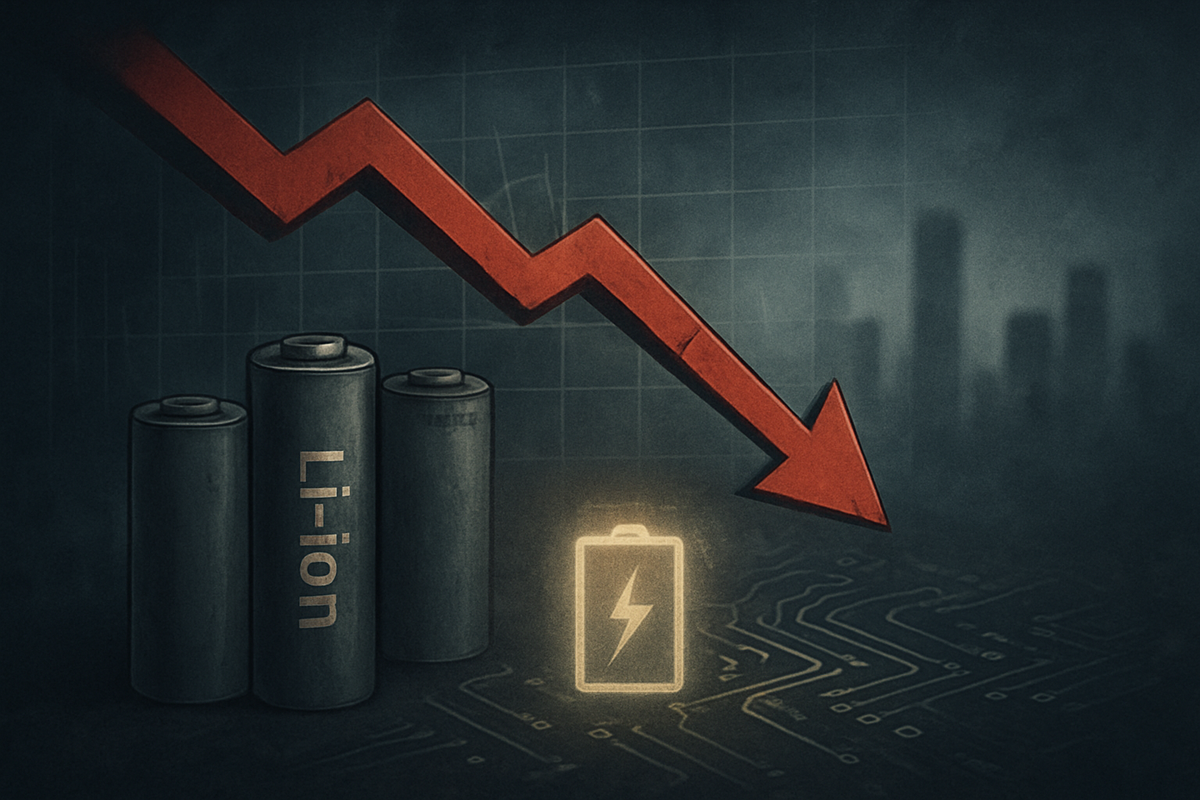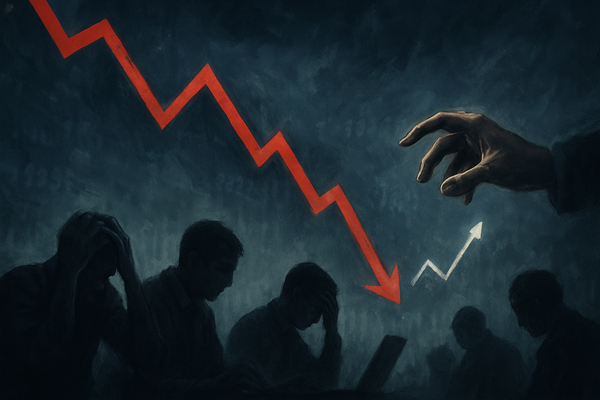Dragonfly Energy's Stock Plunge: A Buying Opportunity or a Warning Sign Amidst Market Turmoil?

Dragonfly Energy (NASDAQ: DFLI), a prominent player in the lithium-ion battery sector, has seen its stock price plummet in recent months, largely due to a series of dilutive public offerings and heightened market uncertainty. This precipitous decline has left investors grappling with a critical question: does this represent a compelling buying opportunity for a company operating in a high-growth industry, or does it signal deeper, more systemic financial distress? The ongoing volatility underscores a challenging environment for companies reliant on capital injections, particularly as broader macroeconomic headwinds make investors increasingly risk-averse.
The company's repeated trips to the capital markets, often at significant discounts, have triggered sharp sell-offs, eroding shareholder value and raising red flags about its financial stability. These events are unfolding against a backdrop of a cautious market, where even promising sectors like renewable energy are not immune to investor scrutiny regarding profitability and sustainable growth. For MarketMinute, understanding the nuances of Dragonfly Energy's predicament is crucial for investors seeking to navigate the complex landscape of today's financial markets.
A Cascade of Dilution: Unpacking Dragonfly Energy's Recent Capital Raises
Dragonfly Energy's stock trajectory has been dominated by a succession of public offerings designed to shore up its balance sheet, yet each has come at a steep cost to its share price. The timeline of these events paints a clear picture of a company in urgent need of capital, facing an increasingly skeptical market.
The troubles began to escalate on July 30, 2025, when Dragonfly Energy announced an underwritten public offering of 21,980,000 shares at a mere $0.25 per share. This move, intended to raise approximately $5.5 million, sent the stock tumbling by 27.8% as existing shareholders recoiled from the substantial dilution. The stated purpose was to fund working capital, general corporate purposes, and debt repayment, highlighting immediate financial pressures.
Just over two months later, on October 6, 2025, the company again sought capital, pricing another underwritten public offering for 20 million shares at $1.25 each. This price represented a significant discount from the prior Friday's closing price of $1.89, leading to an approximate 30% plunge in DFLI's stock on the announcement day. The $25 million target from this offering underscored a persistent need for funds, further fueling investor concerns about the company's long-term financial health.
The most substantial capital raise followed swiftly on October 16, 2025, with Dragonfly Energy disclosing a $55.4 million public offering. This complex offering included 36 million shares of common stock at $1.35 per share and pre-funded warrants for up to 5 million shares at $1.3499 per warrant. Again, the offering price was notably below the previous day's closing price of $1.97, causing a 13% drop in the stock. The primary goal of this larger offering was to prepay $45 million of outstanding debt, alongside providing working capital.
These offerings have been met with overwhelmingly negative reactions from the market. Investors, the key stakeholders here, have consistently responded by selling off shares, reflecting deep concerns over the dilution of their holdings and the company's ability to achieve sustained profitability. Analysts have noted the "precarious" financial position of Dragonfly Energy, characterized by deeply negative EBIT and net profit margins (-39.3% and -55.84%, respectively), and a significant debt load. Furthermore, the company has been battling to maintain compliance with Nasdaq listing requirements, specifically the minimum bid price and market value standards, with a critical deadline looming on November 10, 2025. This series of events paints a picture of a company struggling to find its footing amidst challenging market conditions and a pressing need for capital.
The Ripple Effect: Who Wins and Who Loses in Dragonfly Energy's Struggle
Dragonfly Energy's (NASDAQ: DFLI) stock performance and financial maneuvers have significant implications, not only for the company itself but also for its competitors and the broader energy storage market. While Dragonfly Energy is clearly in a challenging position, its struggles could create opportunities for others, while also signaling potential headwinds for the sector as a whole.
Dragonfly Energy (NASDAQ: DFLI) - The Primary Loser: The most immediate and apparent loser is Dragonfly Energy itself, and by extension, its existing shareholders. The repeated dilutive offerings have severely depressed the stock price, eroding shareholder value significantly. The company's negative profitability metrics (EBIT margin of -39.3%, net profit margin of -55.84%) and substantial debt ($88.37 million in liabilities against $71.77 million in assets as of June 30, 2025) paint a grim financial picture. While the capital raises provide a lifeline for operations and debt reduction, they do so at the expense of shareholder equity. The declining direct-to-consumer (DTC) sales, even partially offset by growth in the OEM segment, indicate market resistance or competitive pressures. The looming Nasdaq compliance deadline adds another layer of risk, with potential delisting further damaging investor confidence and liquidity. The company's ability to pivot towards sustainable profitability without continuous reliance on dilutive offerings will be critical for its survival.
Competitors - Potential Winners, but with Caution: Competitors in the lithium-ion battery and portable power solutions space could potentially benefit from Dragonfly Energy's woes. Companies with stronger balance sheets, established profitability, or less reliance on frequent capital raises might gain market share, especially if customers perceive Dragonfly Energy as unstable. For example, larger, more diversified energy storage companies or those specializing in specific niches (e.g., RV, marine, off-grid solutions) might see an opportunity to attract customers or talent. However, the broader market uncertainty that has contributed to DFLI's struggles could also impact these competitors. If investor sentiment sours on the entire sector due to one company's difficulties, even strong players might face increased scrutiny or reduced valuations. Therefore, while individual competitors might gain, the overall industry could experience a temporary dampening of enthusiasm.
The Lithium-ion Battery Market - Mixed Signals: The event sends mixed signals to the broader lithium-ion battery market. On one hand, it highlights the intense competition and the capital-intensive nature of scaling operations in this sector. It underscores that even in a high-growth industry, a clear path to profitability and prudent financial management are paramount. On the other hand, the underlying demand for lithium-ion batteries in various applications (RV, marine, off-grid, residential storage) remains robust due to the global shift towards renewable energy and electrification. Dragonfly Energy's specific challenges might be company-specific rather than indicative of a fundamental flaw in the market demand for its products. Nevertheless, investors in the sector will likely become more discerning, prioritizing companies with strong fundamentals, diversified revenue streams, and a proven ability to manage debt and capital efficiently. This could lead to a flight to quality within the industry, favoring established players or those with innovative, cost-effective technologies and solid financial footing.
Wider Significance: A Bellwether for High-Growth, Capital-Intensive Industries
Dragonfly Energy's (NASDAQ: DFLI) current struggles extend beyond a single company's financial woes; they serve as a potent bellwether for broader trends impacting high-growth, capital-intensive industries, particularly those within the renewable energy and electrification sectors. The company's reliance on repeated dilutive offerings amid a tight capital market environment highlights systemic challenges that could ripple through the entire industry.
Broader Industry Trends and Ripple Effects: The lithium-ion battery market is undeniably a growth sector, driven by the accelerating adoption of electric vehicles, renewable energy storage, and portable power solutions. However, DFLI's situation underscores that growth potential alone is insufficient. The industry requires substantial capital investment for research and development, manufacturing scale-up, and market penetration. When a company like Dragonfly Energy, despite being in a promising sector, struggles to achieve profitability and requires frequent capital injections, it can cool investor enthusiasm for the entire segment. This could lead to increased scrutiny for other emerging battery manufacturers or energy storage solutions providers, potentially making it harder for them to raise capital, especially if they also operate with negative margins or significant debt. Competitors with more robust financial models or diversified revenue streams, such as larger conglomerates or established players like LG Energy Solution (KRX: 373220) or Panasonic (TYO: 6752), may be seen as safer bets, potentially consolidating market power.
Regulatory and Policy Implications: While Dragonfly Energy's challenges are primarily financial, they could indirectly influence regulatory and policy discussions. Governments worldwide are pushing for energy independence and decarbonization, creating favorable policy environments for renewable energy and battery storage. However, if a series of high-profile companies in this sector face financial distress, it might prompt policymakers to re-evaluate support mechanisms, funding structures, or even intellectual property protection to ensure the stability and competitiveness of their domestic industries. For instance, there might be increased focus on "Made in America" incentives to support local battery production, but also a more rigorous assessment of the financial viability of companies receiving public funds or tax credits. The Nasdaq compliance issues also highlight the importance of maintaining market integrity and robust listing standards, ensuring that public companies meet certain financial health benchmarks.
Historical Precedents and Comparisons: Dragonfly Energy's situation draws parallels to past cycles in nascent, capital-intensive industries, such as the dot-com bubble or early stages of solar energy development. In those periods, many companies with promising technologies but unproven business models or unsustainable cash burn rates ultimately failed or were acquired at distressed valuations. The key takeaway from history is that while innovation is vital, a clear path to profitability and efficient capital management are equally, if not more, important for long-term survival. Companies like Solyndra, which received significant government backing but ultimately went bankrupt, serve as stark reminders that even strong tailwinds cannot overcome fundamental business model flaws or poor financial execution. Dragonfly Energy's repeated reliance on dilutive offerings at discounted prices mirrors the desperation seen in companies during such periods, signaling a potential struggle for survival rather than a temporary dip.
What Comes Next: Navigating a Perilous Path
The future for Dragonfly Energy (NASDAQ: DFLI) is fraught with both significant challenges and potential, albeit limited, opportunities. The coming months will be critical in determining whether the company can stabilize its financial position and regain investor confidence, or if it will face further erosion of value and potentially more drastic measures.
Short-Term and Long-Term Possibilities: In the short term, the immediate focus for Dragonfly Energy must be on achieving and maintaining Nasdaq compliance, particularly regarding its minimum bid price. Failure to do so by the November 10, 2025, deadline could lead to delisting, severely impacting liquidity and investor access. The company will likely continue to optimize its operational efficiency, cut costs, and push for increased sales, especially in its growing OEM segment, to reduce its cash burn. Long-term, the company's survival hinges on its ability to transition from a capital-intensive, loss-making entity to a sustainably profitable one. This would require a clear strategy for market penetration, technological differentiation, and robust financial management that avoids further significant dilution.
Potential Strategic Pivots or Adaptations Required: Dragonfly Energy may need to consider several strategic pivots. This could include exploring partnerships or joint ventures with larger, financially stable companies that can provide capital, manufacturing expertise, or broader market reach without resorting to further dilutive public offerings. A more aggressive focus on specific, highly profitable niches within the lithium-ion battery market, rather than a broad approach, could also be a viable strategy. The company might also need to re-evaluate its product portfolio, potentially divesting less profitable segments or doubling down on those with higher margins and clearer competitive advantages. Acquisitions by a larger player, though likely at a distressed valuation, also remain a possibility if the company's financial position does not improve.
Market Opportunities or Challenges That May Emerge: Despite its current woes, the underlying market for lithium-ion batteries continues to grow. If Dragonfly Energy can successfully navigate its financial challenges, it could capitalize on the increasing demand for energy storage solutions in RVs, marine applications, and off-grid systems. The company's technology, if competitive, still holds potential. However, the primary challenge will be to rebuild investor trust and demonstrate a credible path to profitability. The market will be looking for sustained positive cash flow, significant improvements in profit margins, and a reduction in debt. Any further missteps or continued reliance on dilutive funding will exacerbate its challenges and make it increasingly difficult to attract new investment.
Potential Scenarios and Outcomes: Several scenarios could play out. In an optimistic scenario, the recent capital raises provide sufficient runway for Dragonfly Energy to execute a successful turnaround, improve its financial metrics, and regain Nasdaq compliance, leading to a gradual recovery in its stock price. A more neutral outcome might see the company stabilize but remain a niche player, perpetually struggling with profitability and valuation. The pessimistic scenario involves continued financial distress, failure to meet Nasdaq requirements, further dilution, or even bankruptcy, leading to a complete loss for current shareholders. Investors should closely monitor the company's financial reports, sales figures, and any announcements regarding strategic partnerships or operational changes to assess which path Dragonfly Energy is taking.
Comprehensive Wrap-up: A Test of Resilience in a Volatile Market
Dragonfly Energy's (NASDAQ: DFLI) recent stock performance and financial maneuvers serve as a stark reminder of the inherent risks and intense pressures faced by companies in capital-intensive, high-growth industries, especially during periods of elevated market uncertainty. The repeated dilutive public offerings, while providing necessary capital, have come at a significant cost to shareholders, raising fundamental questions about the company's long-term viability and its ability to achieve sustainable profitability.
Summary of Key Takeaways: The core issue for Dragonfly Energy is a precarious financial position characterized by negative profitability, substantial debt, and a persistent need for external capital. While operating in a booming lithium-ion battery market, the company has struggled to translate revenue growth, particularly in its OEM segment, into positive earnings. The immediate market reaction to each offering—sharp stock price declines—underscores investor apprehension regarding dilution and the erosion of shareholder value. Furthermore, the looming Nasdaq compliance deadline adds an urgent layer of risk, with potential delisting threatening the stock's liquidity and investor appeal.
Assessment of the Market Moving Forward: For the broader market, Dragonfly Energy's situation highlights a crucial shift in investor sentiment. In a volatile economic climate, investors are increasingly prioritizing financial stability, clear paths to profitability, and prudent capital management over pure growth narratives. This could lead to a "flight to quality" within the energy storage sector, favoring companies with stronger balance sheets, proven business models, and less reliance on frequent capital raises. While the demand for lithium-ion batteries remains robust, the market will likely become more discerning, rewarding efficiency and financial discipline.
Final Thoughts on Significance and Lasting Impact: Dragonfly Energy's journey is a test of resilience. It will determine whether a company with promising technology in a critical industry can overcome significant financial hurdles without completely sacrificing shareholder value. Its outcome could serve as a case study for how emerging companies navigate the treacherous waters of public markets while attempting to scale operations. The lasting impact will be felt not just by DFLI shareholders but also by other companies in similar positions, who will undoubtedly learn from its successes and failures in securing capital and managing investor expectations.
What Investors Should Watch For in Coming Months: Investors in Dragonfly Energy, or those considering it, should meticulously monitor several key indicators. First, watch for any announcements regarding Nasdaq compliance and the company's ability to maintain its listing. Second, pay close attention to quarterly earnings reports, specifically focusing on improvements in gross margins, a reduction in operating expenses, and any signs of positive cash flow from operations. Third, scrutinize any future capital-raising activities—are they less dilutive, or does the company still need to offer steep discounts? Finally, observe any strategic partnerships, new product launches, or shifts in market strategy that could signal a pivot towards a more sustainable business model. The next few months will be pivotal in determining whether Dragonfly Energy can transform its current challenges into a foundation for future growth or if its stock drop signals deeper, more intractable issues.
This content is intended for informational purposes only and is not financial advice



